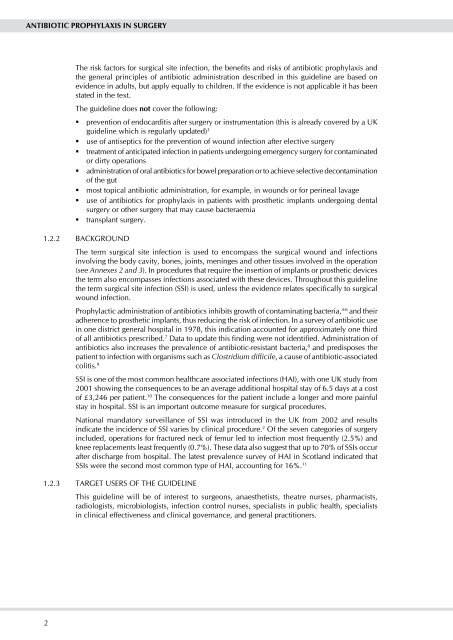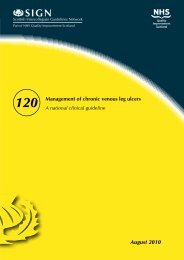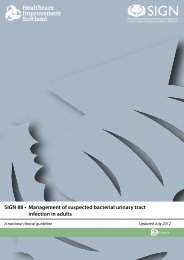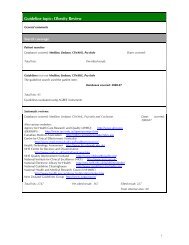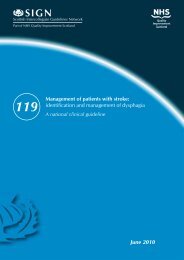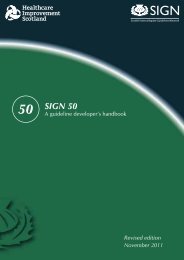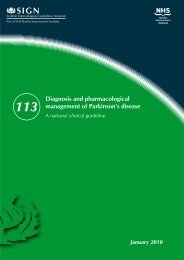Antibiotic prophylaxis in surgery. (SIGN Guideline No 104)
Antibiotic prophylaxis in surgery. (SIGN Guideline No 104)
Antibiotic prophylaxis in surgery. (SIGN Guideline No 104)
Create successful ePaper yourself
Turn your PDF publications into a flip-book with our unique Google optimized e-Paper software.
<strong>Antibiotic</strong> prophylAxis <strong>in</strong> <strong>surgery</strong><br />
2<br />
The risk factors for surgical site <strong>in</strong>fection, the benefits and risks of antibiotic <strong>prophylaxis</strong> and<br />
the general pr<strong>in</strong>ciples of antibiotic adm<strong>in</strong>istration described <strong>in</strong> this guidel<strong>in</strong>e are based on<br />
evidence <strong>in</strong> adults, but apply equally to children. If the evidence is not applicable it has been<br />
stated <strong>in</strong> the text.<br />
The guidel<strong>in</strong>e does not cover the follow<strong>in</strong>g:<br />
prevention of endocarditis after <strong>surgery</strong> or <strong>in</strong>strumentation (this is already covered by a uK<br />
guidel<strong>in</strong>e which is regularly updated) 3<br />
use of antiseptics for the prevention of wound <strong>in</strong>fection after elective <strong>surgery</strong><br />
treatment of anticipated <strong>in</strong>fection <strong>in</strong> patients undergo<strong>in</strong>g emergency <strong>surgery</strong> for contam<strong>in</strong>ated<br />
or dirty operations<br />
adm<strong>in</strong>istration of oral antibiotics for bowel preparation or to achieve selective decontam<strong>in</strong>ation<br />
of the gut<br />
most topical antibiotic adm<strong>in</strong>istration, for example, <strong>in</strong> wounds or for per<strong>in</strong>eal lavage<br />
use of antibiotics for <strong>prophylaxis</strong> <strong>in</strong> patients with prosthetic implants undergo<strong>in</strong>g dental<br />
<strong>surgery</strong> or other <strong>surgery</strong> that may cause bacteraemia<br />
transplant <strong>surgery</strong>.<br />
1.2.2 BACKGRouND<br />
The term surgical site <strong>in</strong>fection is used to encompass the surgical wound and <strong>in</strong>fections<br />
<strong>in</strong>volv<strong>in</strong>g the body cavity, bones, jo<strong>in</strong>ts, men<strong>in</strong>ges and other tissues <strong>in</strong>volved <strong>in</strong> the operation<br />
(see Annexes 2 and 3). In procedures that require the <strong>in</strong>sertion of implants or prosthetic devices<br />
the term also encompasses <strong>in</strong>fections associated with these devices. Throughout this guidel<strong>in</strong>e<br />
the term surgical site <strong>in</strong>fection (SSI) is used, unless the evidence relates specifically to surgical<br />
wound <strong>in</strong>fection.<br />
Prophylactic adm<strong>in</strong>istration of antibiotics <strong>in</strong>hibits growth of contam<strong>in</strong>at<strong>in</strong>g bacteria, 4-6 and their<br />
adherence to prosthetic implants, thus reduc<strong>in</strong>g the risk of <strong>in</strong>fection. In a survey of antibiotic use<br />
<strong>in</strong> one district general hospital <strong>in</strong> 1978, this <strong>in</strong>dication accounted for approximately one third<br />
of all antibiotics prescribed. 7 Data to update this f<strong>in</strong>d<strong>in</strong>g were not identified. Adm<strong>in</strong>istration of<br />
antibiotics also <strong>in</strong>creases the prevalence of antibiotic-resistant bacteria, 8 and predisposes the<br />
patient to <strong>in</strong>fection with organisms such as Clostridium difficile, a cause of antibiotic-associated<br />
colitis. 9<br />
SSI is one of the most common healthcare associated <strong>in</strong>fections (HAI), with one uK study from<br />
2001 show<strong>in</strong>g the consequences to be an average additional hospital stay of 6.5 days at a cost<br />
of £3,246 per patient. 10 The consequences for the patient <strong>in</strong>clude a longer and more pa<strong>in</strong>ful<br />
stay <strong>in</strong> hospital. SSI is an important outcome measure for surgical procedures.<br />
National mandatory surveillance of SSI was <strong>in</strong>troduced <strong>in</strong> the uK from 2002 and results<br />
<strong>in</strong>dicate the <strong>in</strong>cidence of SSI varies by cl<strong>in</strong>ical procedure. 2 of the seven categories of <strong>surgery</strong><br />
<strong>in</strong>cluded, operations for fractured neck of femur led to <strong>in</strong>fection most frequently (2.5%) and<br />
knee replacements least frequently (0.7%). These data also suggest that up to 70% of SSIs occur<br />
after discharge from hospital. The latest prevalence survey of HAI <strong>in</strong> Scotland <strong>in</strong>dicated that<br />
SSIs were the second most common type of HAI, account<strong>in</strong>g for 16%. 11<br />
1.2.3 TARGET uSERS oF THE GuIDElINE<br />
This guidel<strong>in</strong>e will be of <strong>in</strong>terest to surgeons, anaesthetists, theatre nurses, pharmacists,<br />
radiologists, microbiologists, <strong>in</strong>fection control nurses, specialists <strong>in</strong> public health, specialists<br />
<strong>in</strong> cl<strong>in</strong>ical effectiveness and cl<strong>in</strong>ical governance, and general practitioners.


